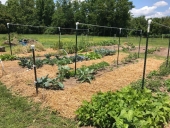
 5
5




Thanks, Y'all!
 6
6




 2
2




Thanks, Y'all!
 8
8




Life on a farm is a school of patience; you can't hurry the crops or make an ox in two days.
Henri Alain
 3
3




Stacie said, "But back to the volunteers...
Invasive plants are Earth's way of insisting we notice her medicines. Stephen Herrod Buhner
Everyone learns what works by learning what doesn't work. Stephen Herrod Buhner

 2
2




 5
5




Nothing ruins a neighborhood like paved roads and water lines.
 1
1




(Reminder to myself) God didn't say, "well said, well planned, and well thought out." He said, "well done."
Nikki's Wishlist
 2
2




Education: "the ardent search for truth and its unselfish transmission to youth and to all those learning to think rigorously, so as to act rightly and to serve humanity better." - John Paul II

|
We don't have time for this. We've gotta save the moon! Or check this out:
The new gardening playing cards kickstarter is now live!
https://www.kickstarter.com/projects/paulwheaton/garden-cards
|




